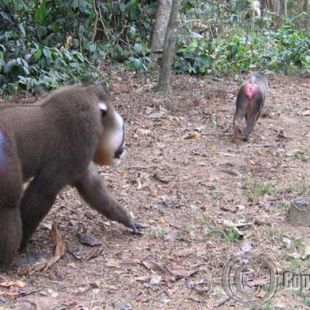The Life of an Adult Male Drill
As they move toward adulthood, young males no longer spend as much time with their mothers and sisters. Typcially, they become a target of the dominant male's aggression as subadults (depending on how much they are following their hormonal urges!) and begin to become more peripheral in the group. Solitary males have been observed in the wild, so it is believed that a male may leave a group to find opportunities elsewhere. A male may also stay in the group and take his chances at besting the reigning dominant male.
In a drill group, adult males fight for dominance and control of breeding opportunities. The dominant male performs a behavior called 'mate gaurding'; this means that he monopolizes matings with receptive females and is aggressive toward other males who approach these females. Being dominant is an exhaustive position, to say the least - a group of females comes into estrus during the same season and the dominant male must not only satisfy all these females, but also keep a close eye on the efforts of subordinate males to sneak off into the forest with willing females! Because of this, a dominant male's tenure is believed to be about 3 years. After this, another male usually bests him in a contest of wills. Sometimes it is a peaceful takeover - obtained by means of 'threat displays'. A drill 'threat yawn' involves the male showing his teeth to another male - it may look like a yawn (and maybe it is - no one can yet fully explain the causes of yawning) or it may be a threat display - the sight of the 2 inch long canines and the musculature associated with the jaw gape of an adult male drill show another male just what he will be facing in a fight! Often, this assessment of one another's weaponry may be enough to actually prevent a fight.
Actual fights are rare, but do happen. When posturing, males will sit facing one another and yawn and gnash their teeth. In actual aggressive contact, a male will hold out a hand and try to grab the other - if they make contact, they will grasp one another's arms and grapple, with the winner likely to be the one who gets in the best bite. However, a male can't forget about the group - a successful dominant male is backed by the larger social group, especially the females, who watch the contest closely. The dominant females may even influence the outcome by standing between the two during a fight, or supporting one over the other. Juveniles in the group don't get involved, but seem to find male contests highly entertaining stuff. They will sit nearby and follow the specktacle as if they are in a theater, watching a movie!

























